I put this article together to help you choose some tried and true, no-nonsense fishing lures. There are a million lure choices out there today, and it is easy to get overwhelmed. There are more lure companies than ever before, and lures are sold in an almost infinite array of sizes, designs, actions, and colors/patterns. Some are high quality, and some are junk not worth buying. Keeping lure selection simple, as with all other aspects of fishing, works and works well.
Let’s jump right into it. In the sections below, I’ll discuss different classes of common lures, and will highlight their strengths and disadvantages.
Swim Bait and Old School Shrimp Tail


These are the dynamic duo and will catch the crap out of just about anything. Don’t leave home without em’. I wrote a detailed article (here) about my preference for the Saltwater Assassin Sea Shad (a type of swim bait) and Kelly Wigglers (a type of old school shrimp tail), so I won’t rehash the details here. There are many swimbaits on the market these days, and they all catch fish, so choose what you like.
Fluke/Jerkbait
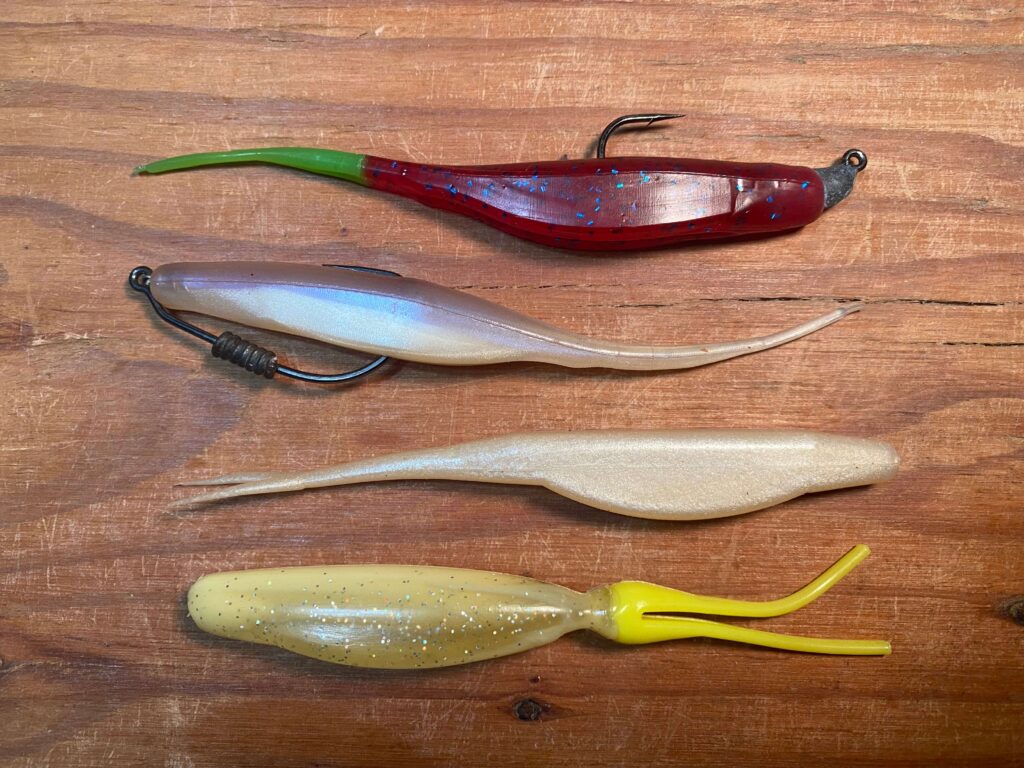
Advantages:
- Aggressive “3D action” darting action; when you pop it, it darts in random directions.
- Ability to rig weedless; great for working around mats of very thick grass in shallow water.
- Very slow slow sinker when rigged weedless.
- Ability to use as a finesse bait in very shallow water.
Disadvantages:
- Requires a lot of wrist popping to work this bait and it can get tiring.
- The darting action can twist line no spinning reels.
Situations where flukes are handy:
- Just about anywhere, this is a good all rounder.
- Flukes that have the open slot on the bottom, are great for rigging weedless (see the second one from the top in the photo).
Brands to try:
- Saltwater Assassin
- Zoom Lures (find these in the bass fishing section; usually cheaper than Saltwater Assassins).
- Texas Trout Killer/Texas Trout Killer II
- Norton Lures
Topwater Chugger/Popper
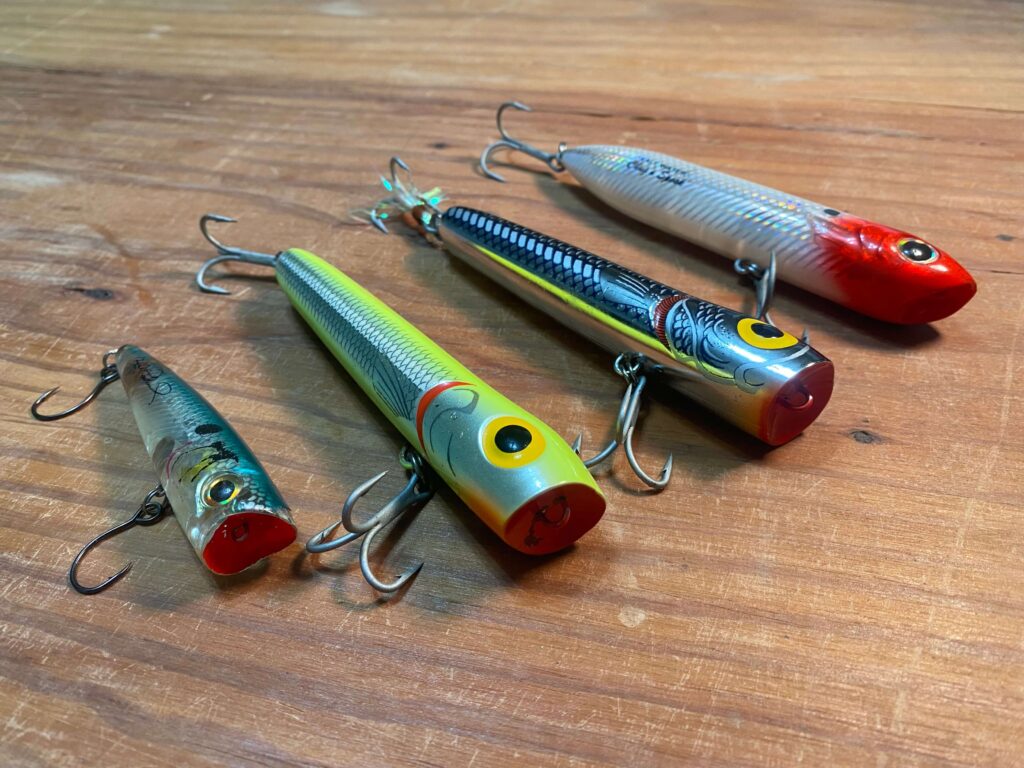
Advantages:
- Topwater “popping” action.
- Easy to work (a bit easier than walking the dog).
- Can fish it aggressively, or subtly (i.e., barely pop it).
Disadvantages:
- Not a great/fast search bait.
- Fairly boring to work of fish aren’t around.
Situations where topwater poppers are handy:
- Good option for fishing topwater when it is too choppy to use walking baits (good surf option).
- I have cast small poppers to tailing redfish and caught them without spooking them, because the small lures don’t make a lot of commotion.
- Good lure to cast right up to shoreline grass or mangroves; you can gently pop it in place without moving the lure much.
Brands to try:
- Storm Lures, particularly the “Chug Bug”
- Rebel, particularly the Super Pop-R
- Yo-Zuri
- Heddon
- Mirrolure
- Rapala
Topwater Walkers

Advantages:
- Topwater “walk-the-dog” (i.e., “zig-zag”) action.
- Most are quite heavy, and you can cast them a very long way, covering lots of water
- They can be worked slow, fast, evenly, or erratically.
- The zig-zag action, along with internal rattles that most have, really attracts fish.
- The volume of the internal rattles typically ranges from moderate to loud; loud topwaters are a good option to attract fish when the water gets dirty.
- Fun and challenging to work.
Disadvantages:
- Walking the dog can be tiring after a while.
- They easily pick up grass, and grass kills the walking action.
- Can be difficult (but not impossible) to work in choppy water.
Situations where topwater walkers are handy:
- Any time fish are feeding aggressively on the surface.
- Fishing at dawn around thick pods of mullet.
- Baits with loud rattles (i.e., “high-pitch” baits) are good for attracting attention in stirred up or dirty water conditions.
Brands to try:
- Heddon, particularly the Super Spook, Super Spook Jr, and One Knocker
- Mirrolure, particularly the Top Dog, Top Dog Jr, and Top Pup
DOA Baitbuster

Advantages:
- Creating a vibration while it skims the surface of the water (it is not a topwater, but is more of a “subsurface skimmer”.
- Good shallow water search lure.
- Large profile than typical swimbaits.
- More buoyant than typical swimbaits.
- Easy to cast and retrieve.
- Easier to fish than a topwater, and not affected much by chop.
Disadvantages:
- Doesn’t cast far.
- Not weedless.
- Generates vibration, but no sound.
Situations where the DOA Baitbuster is handy:
- Fishing any shallow water area where the grass isn’t too thick.
- Fishing main bay shorelines (sandy shorelines) under choppy conditions where walking topwaters are hard to fish.
Twitchbaits (Moderate Suspenders/Sinkers)

Advantages:
- Fishing the mid-water column at moderate speeds.
- Does a great job of resembling common baitfish.
Disadvantages:
- Not good search baits.
- Not weedless.
- Generally no rattles, so no sound.
Situations when moderate sinking twitchbaits are handy:
- These are good all-around choices for mid-water column fishing.
- Sandy shorelines, mud/shell bottom, and grass/sand bottoms where the grass isn’t too thick.
Brands to try:
- Mirrolure, lots of good choices here, including the Mirrodine varieties, scaled sardine (32M), and 51/52 MR.
Twitchbaits (Slow Suspenders/Sinkers)
“Corky” Baits
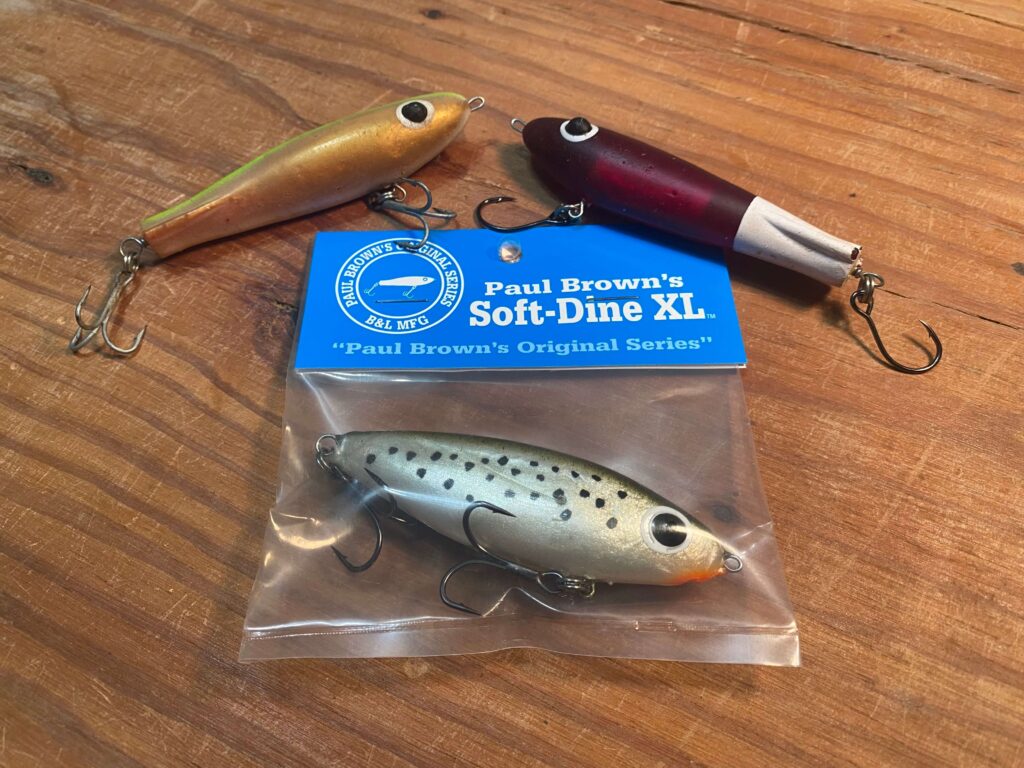
Advantages:
- Excellent slow fishing, finesse bait, with a slow sink rate. Commonly used to entice lethargic trout to bite. This is a go-to lure for big trout anglers.
- Soft exterior (this lure is a hybrid of a plug and soft plastic).
Disadvantages:
- Not good search baits.
- Not weedless.
Situations where the Corky is handy:
- Top choice for sow speckled trout in winter/early spring over mud and shell type bottoms.
- Slow sinking over grass potholes.
- Any time a finess approach is needed.
Mirrolure Catch 2000

Advantages:
- Very slow sink rate suitable for fishing very shallow water; Mirrolure advertises this as a 1-2′ lure.
- Walking the dog just below the surface.
- Can be a good finesse fishing lure, but can be fished aggressively as well.
- Has rattles.
Disadvantages:
- Not a good search bait.
- Not weedless.
- Not generally good for deeper water.
Situations where the Catch 2000 is handy:
- Just about anywhere a shallow water plug is needed, as long as the grass isn’t so bad it gets hung up.
- Shallow areas where mullet are milling.
DOA Shrimp
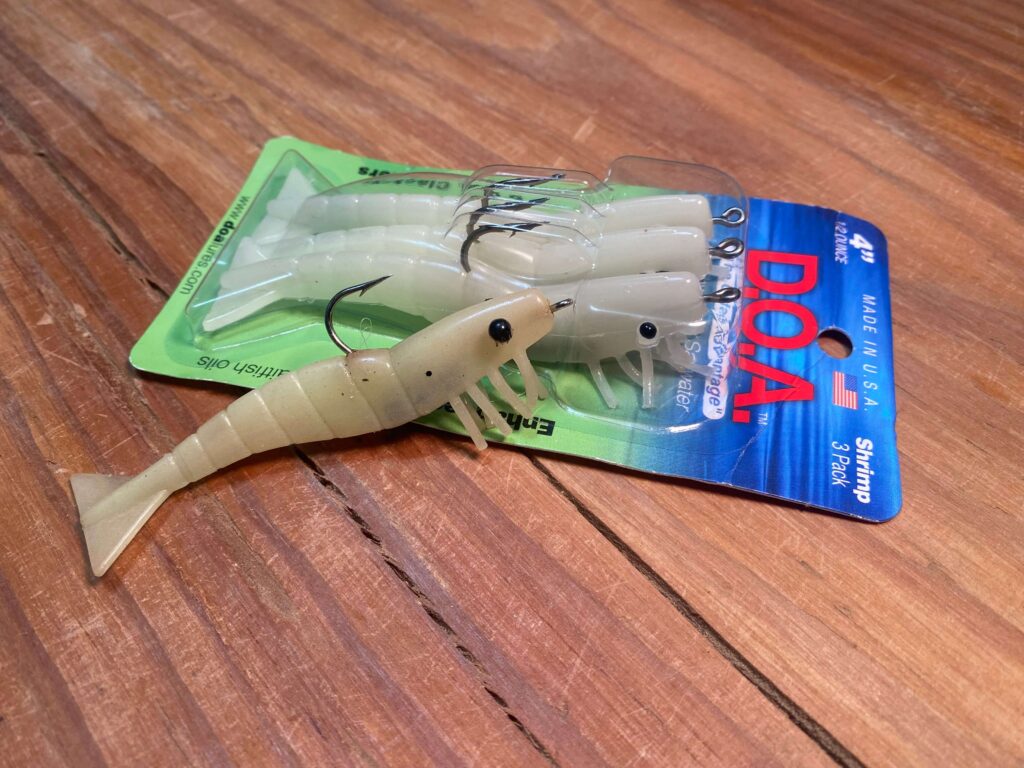
Advantages:
- Looks just like a real shrimp in size, shape, and color.
- Can be fished by itself or under a popping cork.
- Great for fishing mid-water column.
- They are made of tough plastic; you should be able to catch several fish without the body getting destroyed or ripped off.
Disadvantages:
- A bit harder to cast than a shrimp tail on a jig head.
- Not great for fishing the bottom. A shrimp tail (like a Kelly Wiggler) is better for this because it stays on the bottom better.
- Should you need to replace your shrimp body or a rusty hook, only DOA replacement parts (i.e. the shrimp bodies, internal weights, and hooks) can be used together and must be purchased separately. Not a big deal, really.
Situations where the DOA Shrimp is handy:
- Any situation where you want to use a popping cork but don’t have live shrimp.
- Fishing under dock lights at night when trout are around.
- Swimming it across potholes in deeper grass flats.
- Just about anywhere fish are feeding on shrimp.
Lipless Crankbait (i.e., the “Rattletrap”)

Advantages:
- Very aggressive side to side wobble/swimming action; to get this action, all you have to do is reel it.
- Good flash (most of these are chrome colored).
- Ability to sink to a desired depth before you start reeling; great for exploring mid-water column and at deeper depth.
- Can let it sink to the bottom, then reel it (and bump it) along the bottom.
- Is a decent search lure and can be a good trolling lure from a kayak.
Disadvantages:
- Not a great shallow water lure.
- Grass can kill the action.
Situations where this lipless crankbaits are handy:
- Probing sandy, main bay shorelines where there isn’t much grass.
- Probing canals where you can let it sink to deeper waters before reeling.
Spoons
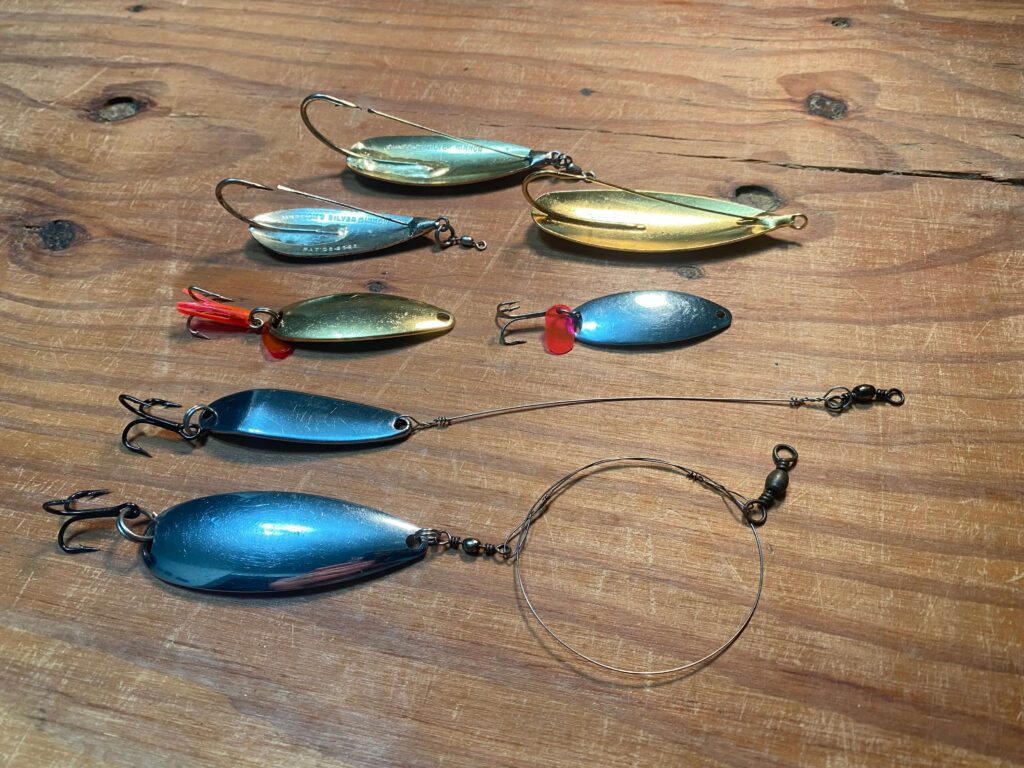
Advantages:
- A very simple bait.
- Thin, curved spoons (like the majority of those pictured above) have “flutter” unlike any other lure. Imagine reeling this lure across a sandy pothole in a grass flat, then stopping your retrieve to let it flutter downwards; this can be very attractive to fish.
- Thicker, narrower spoons (like the Luhr-Jehnsen spoon pictured second from bottom), don’t flutter as readily, but they still have good action, reflect light well, and cast like a missile due to their compact size.
- Gold and silver spoons have a flash unlike most other lures. Weather you choose gold or silver, the flash is a major attractant.
- Can be worked a variety of different ways. A straight retrieve, start/stop retrieve, and jigging can all work.
- Good search lure with a straight retrieve.
- Fish cannot easily destroy it; if you take care of it and don’t let it corrode, it can last a very long time.
- Weedless spoons (those that have the wire covering the hook point) are an excellent options for fishing grass flats.
- Heavier spoons can cast like a missile. They are a good choice when you are fishing in strong winds and may need to cast into them.
- Heavier spoons are great for fishing deeper waters, like the channel side of jetties. You can let them sink and then jig them up from the depths.
Disadvantages:
- Can twist line if you don’t use a swivel.
- Gold and silver coatings will corrode or rub off eventually.
Situations where spoons are handy:
- Weedless gold spoons (typically 1/4 oz) are one of the “gold standards” for redfish on grass flats. It mimics the size and prey that reds like, and it can be fished in thick grass that shuts many other lures down. Don’t be afraid to try silver or other colors.
- Silver spoons, particularly the heavy types like the Krocodile style (the second spoon from the bottom in the photo) are great surf lures for trout and mackerel.
Brands to try:
- Johnson, particularly the Johnson Silver Minnow (weedless) and the Johnson Sprite (not-weedless).
- Luhr-Jehnsen, particularly the Krocodile style.
- Acme, particularly the Kastmaster.
- Sea Striker (styles similar to Luhr-Jehnsen and Acme).
Berkley Gulp Shrimp


Advantages:
- This is the only lure on my list that has scent infused into it. This lure rigged like most soft plastics, but it is not plastic; it is essentially biodegradable food. The lures are sealed in a package of juice when you buy them, and this gives them their flavor. This scent is it’s major strength.
- One of the best lures for black drum, because they are mostly smell oriented (good luck catching them on any other lure). Also a phenominal redfish lure.
- Can be rigged a variety of ways. When rigged on a standard jig head, it is very similar to fishing a kelly wiggler; you can just drag it on the bottom. But it can also be rigged weedless, and can even be rigged backwards for extra casting distance.
- The package that the Gulps come in makes it very convenient to carry them in your tackle box.
Disadvantages:
- It is not a tough lure. You have to rig it carefully because it will rip off of the hook easier than other soft plastics.
- If you allow it to dry out on your hook, it shrinks and hardens up, and can be hard to remove.
- Not the most realistic shrimp imitation.
- You may catch some hardheads.
Situations where Gulps are handy:
- You are out fishing and you run across a school of black drum.
- Fish aren’t hitting your other lures and you need the smell to trigger a bite.
- Dirtier water conditions when the fish are hunting by smell rather than sight.
Good Reasons to Fish With Lures
Fishing with lures is the easiest, most cost effective (in terms of both time and money) and most hassle-free way to fish from a kayak or wading. I also love fishing with bait, and because I love it, I discuss it in this book. However, I probably fish with lures 9 times out of 10. When you fish with lures:
- You do not have to stop to buy bait on your way to your fishing area; you do not have to worry if the bait stand is open, and you are not concerned about the quality of the dead bait or the availability of the live bait.
- You do not have to take the time to catch live bait; sometimes catching bait is easy, but other times it can be a huge hassle and you are itching to get out to your first spot to start fishing.
- No need to cut bait, store bait, or keep it alive. Also, you’re not worried about running out of bait.
- You can rig your rods with lures the night before, and you are 100% ready to go the next day.
- You can go on multiple trips in a row without spending a dime. Yes, soft plastic lures are a “consumable” type of product, and eventually you will need to buy more. But I am usually able to go for several months without buying. Plugs are even better, they can last for many years and may only need to be repainted from time to time.
- Lures make it easier to explore your fishing areas. With lures, not only do you cast more, it is very easy for you to work different depths of the water column, and also feel what is on the bottom.
- Great satisfaction fooling fish with fake bait.
What Lures Try to Mimic
Lures ultimately try to mimic various types of prey items; some imitate wounded prey, and others imitate prey that is just swimming or milling about. The lure’s action, along with it’s other attractive qualities, is intended to help a fish key in on it as an easy meal. Here are what different types of lures try to mimic:
- Plugs typically mimic a small baitfish. Cylindrical plugs mimic finger mullet, and flat-sided plugs mimic flatter fish like shad or menhaden.
- Soft plastics mimic a variety of things. All of the shrimp-style lures, mimic shrimp, obviously. Jerkworms can mimic a baitfish, worm or eel. Swimbaits mimic a small swimming fish.
- Spoons imitate a small, flashing baitfish or crab.
Fishermen have long said that it is important to “match the hatch”, and generally, you should. This means picking a lure that resembles what the fish are feeding on, both the type of prey and the size of prey. So if there are finger mullet pods in your area, it might be wise to try a medium-sized walking topwater that resembles a wounded finger mullet.
However, it is sometimes impossible to predict exactly what a fish will want, and matching the hatch is just a starting point. You may need to try a couple different lures until you key in on what they want. Also, weather and structure conditions often times dictate your lure choices for you. You may “want” to throw a walking topwater that looks like a mullet, but if the grass is too thick, then a weedless gold spoon or weedless jerkbait are much better options.
Soft Plastic Lures vs Hard Baits/Plugs
Flukes and shrimp tails are examples of soft plastic lures. Topwaters are examples of plugs. A Corky is sort of an odd ball, because it is a soft plastic/plug hybrid. Here are a few generally true statements from the fishing community regarding soft plastic lures vs plugs:
- Soft plastics catch more fish, hard baits catch bigger fish.
- Subsurface lures catch more fish, topwater lures catch bigger fish.
- Soft plastics get destroyed easier than plugs, which last longer because they are hard plastic.
- Fish hold onto soft plastic lures longer (after it bites the lure) because it feels more natural in the fish’s mouth.
With that being said, fisherman catch fish all the time with both soft plastics and plugs. I think it is advisable to learn both. All of the lures listed on this page have been proven time and time again that they are fish catching machines. You just have to have the confidence to use them, and match their strengths to your situation.
Lure Colors
Choosing a color can be overwhelming. It is often said that you shouldn’t be overly concerned about the color, because the action of the lure is more important. I think this is good advice and it has served me well. I try to keep my color selection very basic for this reason.
Here is a very basic guide to lure colors based on my experience and what I’ve read:
- In clear or only slightly turbid water, use “natural” colors. This can mean different things to different people, but to me it means to use a color that looks (mostly) like the actual prey. For example, I love swimbaits that have dark green in them, because this resembles baitfish, especially mullet. Hard baits that have shiny chrome sides and dark tops also look natural to me. For shrimp lures, I prefer gold/brown/rootbeer, like a real shrimp.
- As the water moves from clear to green, or as it starts to get just a bit sandy, I still prefer natural colors, but having a little but of chartreuse (i.e., a sort of bright green color) on the tail seems to help the fish find the bait a little easier.
- As the water gets even more cloudy (more brown than green), the fish start to have trouble seeing the bait, so it is generally advised to start using either darker colors (like dark purple, for example), because it creates a silhouette in the murkier water. Or, start using bright/unnatural colors like bright greens, hot pinks, etc. Some say that the key here is that you need something that “sticks out” to the fish so they can key in on it and attack it.
- At night, I have read that it is advised to use dark lures, even black, due to the silhouette that they create, but glow-in-the dark lures can work well too.
- For spoons, I personally prefer a silver spoon for clear or green water, and a gold spoon for stained or turbid water. However, plenty of folks have good luck with various colored spoons as well.
That’s about it for now. I hope this guide will help you select a few lures to start with, without having to buy the whole store. Enjoy your lure fishing!
Have a reel good day,
– The Simple Fisherman
